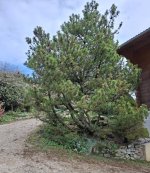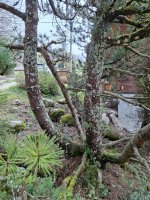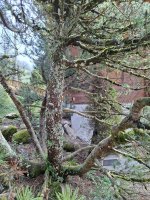pinerider
Seed
Hello Bnuts !
First of all, I am sorry for the long post full of newbie questions! and I would like to take the opportunity of this first post to thank you all for sharing your knowledge and enthusiasm, I found a wealth of information, and will for years and years to come haha.
I'm a real beginner at bonsai, on my way to being completely contaminated, but this is more of a Niwaki topic. I did try to do my homework before coming to you, and right here is where I found the most information about it, which seems to be few and far between elsewhere, further than "look at this cool Japanese technique" and "look at this topiary tribute to the giant poodle" , and "get Jake Hobson's book", which I ordered but will take a few more weeks to arrive in my hands. Jokes aside most content relates to smaller trees or ones that were trained since young, and as a newbie I'm a bit in over my head trying to envision things with a chaotic slightly larger tree.
, and "get Jake Hobson's book", which I ordered but will take a few more weeks to arrive in my hands. Jokes aside most content relates to smaller trees or ones that were trained since young, and as a newbie I'm a bit in over my head trying to envision things with a chaotic slightly larger tree.
That's why I would appreciate your views on two trees that were planted in the yard well before we moved in last year, and seem to have been neglected by the previous owners (as the rest of the yard, we called it the Jumanji when beginning to work on it, and there's a bunch more to do for sure haha).
I'd like to get on track to help them look better in the future, but I'm a bit lost as to the course of actions and wary of doing something dumb (no I won't talk about this beautiful old little trunk I cut off the only remaing needle bearing branche from, I still cringe and cry at night, that will be another thread about yardmadori because one trunk remains, still), so I would love to get your inputs about this situation and what could be done, then I'll be able to dive into available info on specific techniques as the need arises.
I know that they'll never be "Niwakis" per se, as you are supposed to train them since the beginning from what I read, and my expectations aren't for world class looking trees, however I read (here I think, I can't seem to find the post again) that there is a way to get Niwaki-ish results from already established trees, but I can't recall the name for it and even then could not find anything other than this one post when searching online (except a restaurant if I remember correctly lol).
So, off we go! There is this Mugo Pine (roughly 20/25ft high I'd say) and what seems to be a Dwarf Alberta Spruce (or picea glauca 'conica' maybe?) that grew freely. I did not touch them as of now appart from cutting off a lot of the accessible dead wood on the pine, before I receive a taller ladder (this week hopefully) to tackle the rest, and get to the spruce after having your inputs .
.
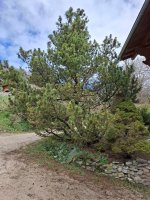


The spruce lost needles and branches probably because it is now in the pine's shade and its own (it is barely half of a tree!), and as you can see below, both are completely off balance regarding growth between the south and north facing sides.


So one way or another I need to open up the canopy wall to allow sun on the currently shaded parts I guess. I'm in the northern French Alps, in zone 7 (from plantmaps.com) at an elevation of about 3300ft (1000m) if it is of importance.
My very first question would be, are the identifications correct ? Not long ago I tough the spruce was a juniper, and honestly I'm still not sure, so... yes, I'm that much of a noob (but so happy about it ), here are upclose shots of their needles if this helps...
), here are upclose shots of their needles if this helps...
The pine:
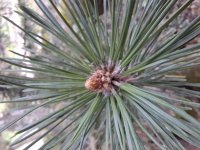


The spruce(?):


The main things I would like some pointers on are: which kind of shapes could/should I aim for in the long run regarding each one, while having them coexist happily in their respective spot, sunlight wise and other considerations I may not even think about, if even possible.
Regarding the pine, with its multiple trunks I was thinking to aim for a Kabudachi style tree, and with the spruce a business casual upright style to give you an idea. This is what corresponds best to their current structures in my newbie eye and mind as a guideline for shaping them, but I may be either completely off the mark here or lack imagination and knowledge to see something else they could become, and would like your opinions about what you would do presented with those two specimens in this situation ?
Now to the scared newbie questions...
Regarding the pine (I did read Vance Wood's compiled posts, thanks a lot for that!) I'll add a few photos from around the tree below in an attempt to make visualising the trunks easier, but I don't know if I succeeded in this lol:
- how can I even start to envision how to open up the canopy while transitionning from this half sphere to horizontal plateaus?
- how would you identify the position of such plateaus to begin with?
- what would you do about the apex(es)? The one nearing the house will have to be cut or bent to point somewhere else for sure.
- Would pruning the top at the same time as exposing the inside to more light create some kind of back budding pick-me-up?
- If so should I wire the flexible needle bearing twigs into tortuous plateau bases beforehand?
- Can I use healthy branches pruned on one side as grafting material for the more barren side ? Is it even possible to use grafting on a tree that size?
I read somewhere that even an expert might have low success rates if any in this case, and you guessed it, I'm not one! Should I let this deter me from trying though?
Even then that would take years I guess to show any success, I'm willing to be patient for it, but maybe there is a more effective way of balancing things out ?
- Did I correctly understand that If a branch or twig has no needles left, it will never bud again, even if there are needles further away on the branch it is attached to, no matter the amount of tree magic involved?
what I really mean is please confort me in cutting all those little dead twigs without second toughts, like this one which will go for sure, I mean in general as there are many many more alike :

- In a situation like this (branche cut carelessly to make way for machinery), should I cut just above the last green twig? Can it kill the green part that remains? Does cutting paste help in a situation like this?


- Is there a way to guesstimate "sufficient" foliage when cutting back? I couldn't find pointers about this while searching, it makes me a bit wary of pruning anything.
I ask this also because of those two lower branches I would like to cut back because now they are claiming my parking spot lol (I'm willing to endure water drops on the back of the neck while getting in the car until it's the right moment to do it though):

- Should I remove the moss and leave the lichen alone? I found it is probably Campylopus introflexus, (considered invasive in the northern hemisphere), so I guess I should. The question is then how do I do that on a tree that size? Would the 50/50 vinegar mix in a spray bottle work? will just allowing more sun in kill it? (I wish lol)
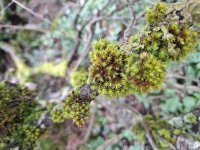
Regarding the (maybe) spruce:
- can it grow new branches on the trunk? How can I tell if there are dormant buds? (I'm thinking of putting a mirror behind it no, poor birds!)
no, poor birds!)
- can I graft healthy branches on the bare part of the trunk to balance the repartition?
- can it back bud on a needle bearing branche if I prune it good once someday? to get the plateaus have foliage back to the trunk.
- will those "buds" herebelow ever sprout if sun gets on them or can I prune all this bushy dead wood without a qualm?
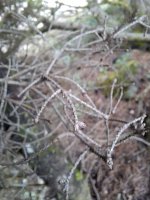
If you made it here, thank you very much for reading this through! (if you skipped to here I can't blame you really ), and sorry again for the basic questions and noob mindset, I couldn't find specific answers to the situation and yes I need some kind of reassurance that I won't do a massacre on those poor trees
), and sorry again for the basic questions and noob mindset, I couldn't find specific answers to the situation and yes I need some kind of reassurance that I won't do a massacre on those poor trees 
Have a nice spring you all !
First of all, I am sorry for the long post full of newbie questions! and I would like to take the opportunity of this first post to thank you all for sharing your knowledge and enthusiasm, I found a wealth of information, and will for years and years to come haha.
I'm a real beginner at bonsai, on my way to being completely contaminated, but this is more of a Niwaki topic. I did try to do my homework before coming to you, and right here is where I found the most information about it, which seems to be few and far between elsewhere, further than "look at this cool Japanese technique" and "look at this topiary tribute to the giant poodle"
That's why I would appreciate your views on two trees that were planted in the yard well before we moved in last year, and seem to have been neglected by the previous owners (as the rest of the yard, we called it the Jumanji when beginning to work on it, and there's a bunch more to do for sure haha).
I'd like to get on track to help them look better in the future, but I'm a bit lost as to the course of actions and wary of doing something dumb (no I won't talk about this beautiful old little trunk I cut off the only remaing needle bearing branche from, I still cringe and cry at night, that will be another thread about yardmadori because one trunk remains, still), so I would love to get your inputs about this situation and what could be done, then I'll be able to dive into available info on specific techniques as the need arises.
I know that they'll never be "Niwakis" per se, as you are supposed to train them since the beginning from what I read, and my expectations aren't for world class looking trees, however I read (here I think, I can't seem to find the post again) that there is a way to get Niwaki-ish results from already established trees, but I can't recall the name for it and even then could not find anything other than this one post when searching online (except a restaurant if I remember correctly lol).
So, off we go! There is this Mugo Pine (roughly 20/25ft high I'd say) and what seems to be a Dwarf Alberta Spruce (or picea glauca 'conica' maybe?) that grew freely. I did not touch them as of now appart from cutting off a lot of the accessible dead wood on the pine, before I receive a taller ladder (this week hopefully) to tackle the rest, and get to the spruce after having your inputs



The spruce lost needles and branches probably because it is now in the pine's shade and its own (it is barely half of a tree!), and as you can see below, both are completely off balance regarding growth between the south and north facing sides.


So one way or another I need to open up the canopy wall to allow sun on the currently shaded parts I guess. I'm in the northern French Alps, in zone 7 (from plantmaps.com) at an elevation of about 3300ft (1000m) if it is of importance.
My very first question would be, are the identifications correct ? Not long ago I tough the spruce was a juniper, and honestly I'm still not sure, so... yes, I'm that much of a noob (but so happy about it
The pine:



The spruce(?):


The main things I would like some pointers on are: which kind of shapes could/should I aim for in the long run regarding each one, while having them coexist happily in their respective spot, sunlight wise and other considerations I may not even think about, if even possible.
Regarding the pine, with its multiple trunks I was thinking to aim for a Kabudachi style tree, and with the spruce a business casual upright style to give you an idea. This is what corresponds best to their current structures in my newbie eye and mind as a guideline for shaping them, but I may be either completely off the mark here or lack imagination and knowledge to see something else they could become, and would like your opinions about what you would do presented with those two specimens in this situation ?
Now to the scared newbie questions...
Regarding the pine (I did read Vance Wood's compiled posts, thanks a lot for that!) I'll add a few photos from around the tree below in an attempt to make visualising the trunks easier, but I don't know if I succeeded in this lol:
- how can I even start to envision how to open up the canopy while transitionning from this half sphere to horizontal plateaus?
- how would you identify the position of such plateaus to begin with?
- what would you do about the apex(es)? The one nearing the house will have to be cut or bent to point somewhere else for sure.
- Would pruning the top at the same time as exposing the inside to more light create some kind of back budding pick-me-up?
- If so should I wire the flexible needle bearing twigs into tortuous plateau bases beforehand?
- Can I use healthy branches pruned on one side as grafting material for the more barren side ? Is it even possible to use grafting on a tree that size?
I read somewhere that even an expert might have low success rates if any in this case, and you guessed it, I'm not one! Should I let this deter me from trying though?
Even then that would take years I guess to show any success, I'm willing to be patient for it, but maybe there is a more effective way of balancing things out ?
- Did I correctly understand that If a branch or twig has no needles left, it will never bud again, even if there are needles further away on the branch it is attached to, no matter the amount of tree magic involved?
what I really mean is please confort me in cutting all those little dead twigs without second toughts, like this one which will go for sure, I mean in general as there are many many more alike :

- In a situation like this (branche cut carelessly to make way for machinery), should I cut just above the last green twig? Can it kill the green part that remains? Does cutting paste help in a situation like this?


- Is there a way to guesstimate "sufficient" foliage when cutting back? I couldn't find pointers about this while searching, it makes me a bit wary of pruning anything.
I ask this also because of those two lower branches I would like to cut back because now they are claiming my parking spot lol (I'm willing to endure water drops on the back of the neck while getting in the car until it's the right moment to do it though):

- Should I remove the moss and leave the lichen alone? I found it is probably Campylopus introflexus, (considered invasive in the northern hemisphere), so I guess I should. The question is then how do I do that on a tree that size? Would the 50/50 vinegar mix in a spray bottle work? will just allowing more sun in kill it? (I wish lol)

Regarding the (maybe) spruce:
- can it grow new branches on the trunk? How can I tell if there are dormant buds? (I'm thinking of putting a mirror behind it
- can I graft healthy branches on the bare part of the trunk to balance the repartition?
- can it back bud on a needle bearing branche if I prune it good once someday? to get the plateaus have foliage back to the trunk.
- will those "buds" herebelow ever sprout if sun gets on them or can I prune all this bushy dead wood without a qualm?

If you made it here, thank you very much for reading this through! (if you skipped to here I can't blame you really
Have a nice spring you all !











